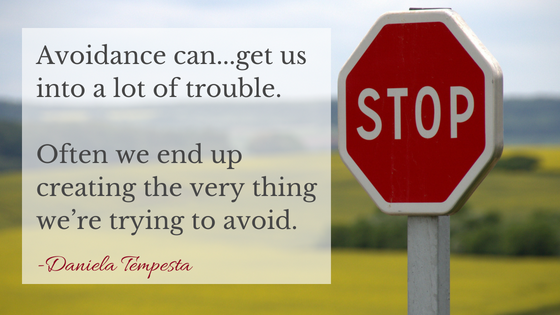Have you ever avoided a conversation or situation out of fear that it might be too uncomfortable? Trust me, you’re not alone. Avoiding that “icky” feeling that you might experience when asking for help or telling someone “no” is so human. Avoidance is something we perceive as a safety behavior so it makes perfect sense why we would do it.
But here’s the problem: avoidance can also serve to get us into a lot of trouble. Often we end up creating the very thing we’re trying to avoid. The tool we used to try to keep us safe actually does the opposite and this can get us stuck in an endless loop of anxiety and avoidance.
To help you navigate your discomfort, and find more productive ways of handling it, I’d like to share some recent examples that I’ve seen with clients in my practice.
The fear of looking incompetent or dumb at work
The fear of looking incompetent or dumb at work is very common, and something that I see often in my practice. Recently, one of my clients was working on a project at work when she had some questions come up about the details of the project. She could have simply asked for help from her colleagues, but she was fearful that she would come across as not knowing what she was doing. To avoid risking that discomfort, she chose not to ask for help.
Unfortunately, because she didn’t have the information she needed, things began to fall through the cracks. She started making mistakes and was unable to finish the project on time. Now, she was facing the very real possibility that she would look look incapable of doing the job. This would not have been the case if she had simply asked for help when she first needed it.
You can see that by avoiding discomfort, she created the very problem that she was trying to prevent. It can be so easy to fall into this trap, so I encourage you to address your discomfort the moment that it appears. That way, you won’t end up with larger problems down the line.
The fear of disappointing yourself or others
The fear of disappointing oneself or others can be very powerful and very damaging and often leads to avoidance. I had a client whose friend asked him to volunteer for a local charity event. My client knew that he just didn’t have the time to commit to the event, but he was terrified of disappointing his friend. It was just too uncomfortable! To avoid that discomfort, he ended up saying yes to his friend when he should have said no.
Then, at the last minute, because he really didn’t have the time, my client gave his friend a flimsy excuse as to why he couldn’t help out at the event. Now his friend was actually disappointed, because he had an expectation. He was counting on my client to be there, and felt really let down by his last minute cancellation. You can see that by attempting to avoid the discomfort of disappointing his friend, my client ended up guaranteeing that he’d be disappointing him.
Unfortunately, this also served to reinforce my client’s fear of disappointing people because he saw how upset his friend was. The truth is, he should have said no at the front end because the disappointment his friend would have felt then is far less than the disappointment that his friend ended up feeling when he didn’t follow through on his commitment.
Evaluating avoidance in your life
Do either of those stories sound familiar to you? Don’t be discouraged! You can start taking steps now to implement real changes in the way that you’ve been handling discomfort.
Here are 3 steps to you can take to avoid unproductive avoidance:
- Sit down and make a list of the things that tend to make you uncomfortable and the way that you tend to avoid them.
- Take a step back and ask yourself “Am I sometimes actually guaranteeing the problem that I’m trying to circumvent?”
- Make a plan for how you might be able to tolerate the discomfort of the thing that you fear on the front end so that you can achieve a better long-term outcome. Commit to that plan and stick with it even in the face of fear or uneasy feelings.
I’m excited to hear from you about how you’ve used these steps! Please send me a message or write a comment to let me know how you’ve implemented them at your job or in your relationship.
Watch the video:




